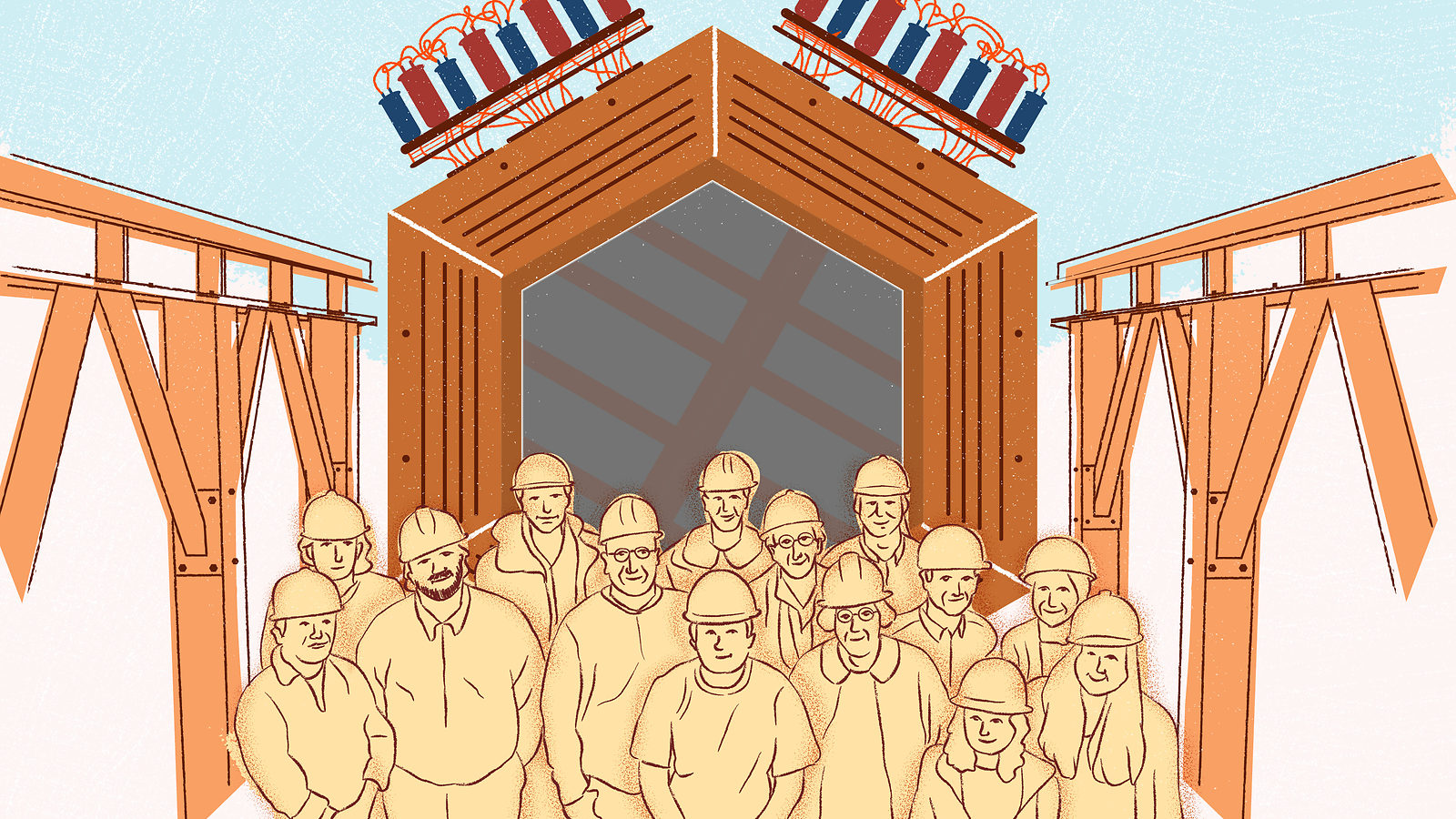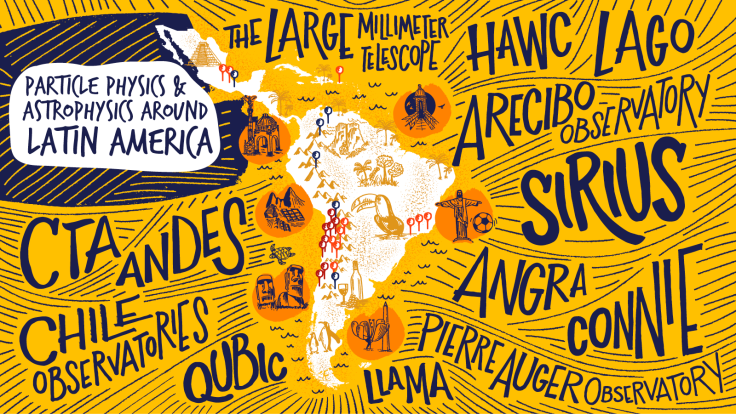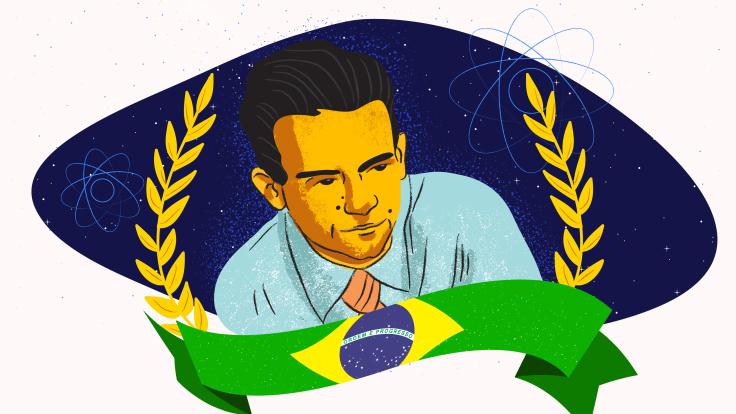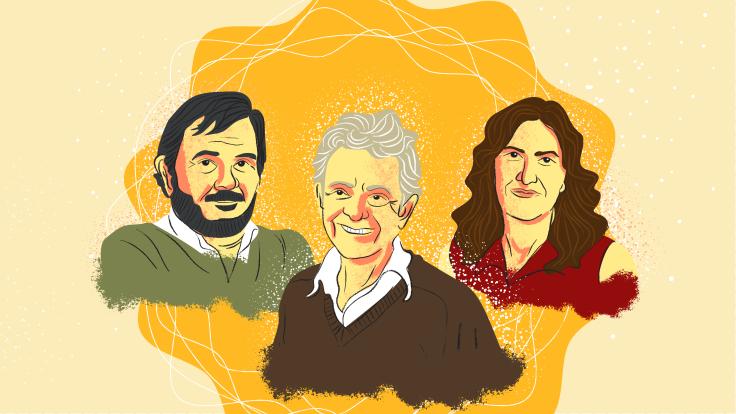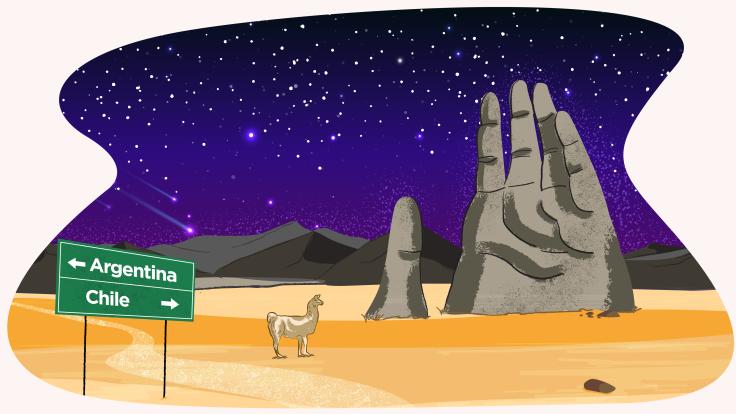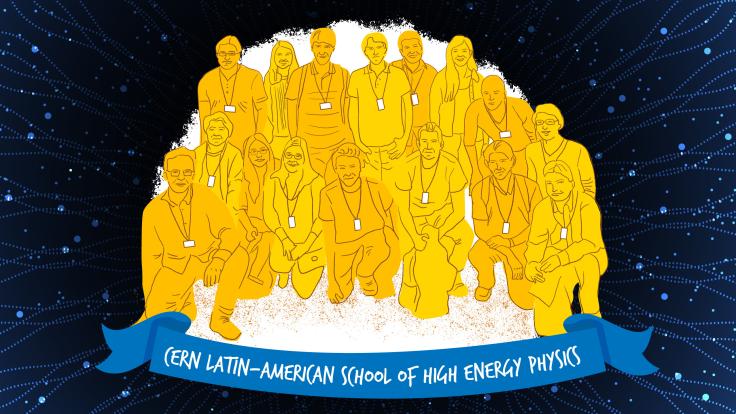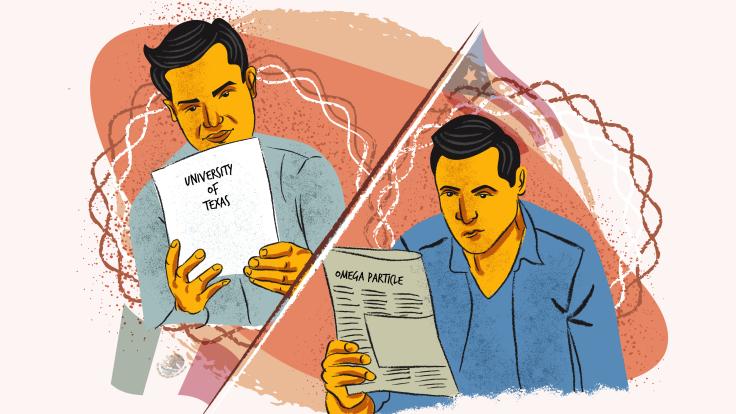On the 12th floor of Wilson Hall, the central high-rise building at Fermi National Accelerator Laboratory outside Chicago, sit the offices and cubicles occupied by members of the MINERvA collaboration.
The MINERvA experiment—which studies how particles called neutrinos and their antimatter counterparts, antineutrinos, interact with different types of materials—finished collecting data in late February. But there is still analysis left to complete.
The area is mostly quiet, but occasionally a conversation will carry down the hall, sometimes in English, sometimes in Spanish or Portuguese.
About a third of the scientists who have participated in the experiment since its inception in 2002 have come from countries in Latin America. Collaborating institutions include Pontifical Catholic University of Peru (PUCP); the National University of Engineering in Peru; the Federico Santa María Technical University in Chile; the University of Guanajuato in Mexico; and the Brazilian Center for Research in Physics (CBPF). The Center for Research and Advanced Studies of the National Polytechnic Insititute (CINVESTAV) in Mexico also recently joined MINERvA. More than 45 students from those institutions have earned or are in the process of earning a degree on the experiment—and some have even earned more than one.
The make-up of the experiment is in some ways a continuation of an effort begun by former Fermilab director and Nobel laureate Leon Lederman to reach out to physicists in Latin America. Most of the Latin American physicists who came to Fermilab in 1970s worked on accelerator-based experiments in specialized particle beam lines or at the laboratory’s particle collider, the Tevatron. Although many of them have moved on to similar experiments at the Large Hadron Collider at CERN, new generations of Latin American scientists are still coming to Fermilab, many of them to study neutrinos.
The large contingent of Latin American scientists on the MINERvA neutrino experiment has added a bilingual component to communication at Fermilab, both in announcing new results and in speaking with potential future physicists. And although MINERvA’s detector operation has come to an end, the partnership between Latin American institutions and Fermilab in neutrino research has only begun.
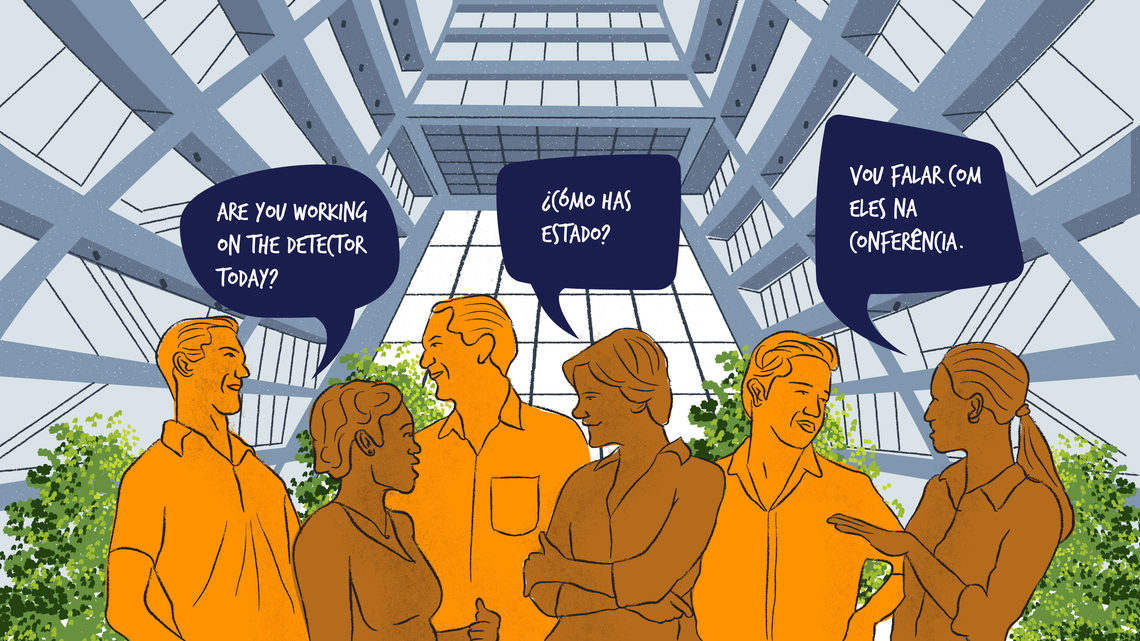
New life for an old partnership
Neutrinos are the most abundant matter particles in the universe. The nuclear fusion that causes the sun and other stars to shine is constantly producing them, as are other nuclear and subatomic processes. Despite this abudance, neutrinos are difficult to study because they rarely interact with other matter, which makes them hard to detect. About 100 trillion neutrinos pass through each person every second, day and night.
Physicist Wolfgang Pauli first postulated the existence of the neutrino in 1930 to explain an apparent anomaly in some types of nuclear decay. Since then scientists have learned much about these elusive partices.
Neutrinos come in three types, called flavors. The 2015 Nobel Prize was split between two scientists from the Super-Kamiokande experiment in Japan and Sudbury Neutrino Observatory in Canada, who in 1998 and 2001 showed that neutrinos change flavors as they move through the universe. The discovery had the surprising implication that neutrinos have at least a small amount of mass—something not predicted in the Standard Model of particle physics. Scientists still do not know where that mass comes from.
Understanding neutrinos could answer important questions about our galaxy and the universe. Neutrinos could play a vital role in the explosions of supernovae, which help galaxies form. They could also have played a role in what our universe is made of: Although the Big Bang should have produced an equal amount of matter and antimatter, which should have annihilated one another completely, somehow we exist in a universe dominated by matter.
The MINERvA experiment is an intermediate step, designed to answer the questions scientists need to ask before they can tackle those big mysteries: What happens when a neutrino interacts with the massive nucleus of an atom? What technology should scientists use to study these strange particles? What should they know about how they interact with different types of materials inside the detectors they might build? Prior to MINERvA, there was no experiment designed to use different materials placed in the same neutrino beamline to determine the best models of how neutrinos and antineutrinos interact with the nuclei of different atoms.
Founding co-spokespersons Jorge Morfín and Kevin McFarland first proposed MINERvA in 2002. The experiment was approved for construction in 2007 with support from the US Department of Energy’s Office of Science.
The MINERvA detector includes a series of hexagonal plates made of different solid materials and tanks of water and liquid helium, each one in the path of the neutrino beam. The active part of the detector is made of solid scintillator. Scientists built it at Fermilab about 100 meters underground, shielded from the interference of cosmic rays raining down from space, in the path of the world’s most intense beams of muon neutrinos and antineutrinos.
Morfín appreciated Lederman’s early efforts to partner with scientists in Latin America and decided to pick up the mantle of keeping those relationships going. Going country by country in 2005, he reached out to the contacts he’d made through working on other experiments at Fermilab. Gradually he convinced a group of Latin American scientists to join MINERvA, and to bring their students with them.
MINERvA started taking data in 2010. Over its nine years of operation, the experiment thoroughly mapped out neutrino interactions with polystyrene, carbon, iron, lead, water and helium.
“The Latin American students and collaborators, analyzing an array of physics topics, have been essential in determining how neutrinos interact with these nuclei,” Morfín says. “And the benefits go both ways.”
Taking part in this crucial step for future neutrino experiments has given students who started their careers on MINERvA a clear path forward.
José Bazo, now an associate professor at PUCP, was one of the first students on MINERvA. When he and fellow students joined the collaboration, the detector was still under construction, so they spent a one-year stint performing simulations. These simulations tested different theoretical models of how the neutrinos fired at the MINERvA detector would collide, depending on the design of the neutrino beam.
By joining MINERvA at the beginning, Bazo and his colleagues were able to shape how the experiment was set up.
MINERvA has continued to provide foundational learning experiences like these for students throughout the years.
Barbara Yaeggy of Chile’s Federico Santa María Technical University first joined the MINERvA collaboration in 2016. She says that at that time, she was overwhelmed. Prior to MINERvA, Yaeggy had only ever worked on theoretical physics, so she’d never had to consider the ins and outs of working with a real-life detector.
“It took me a long time to feel like I had a good idea of what I was doing,” she says. “But eventually you realize that the senior scientists don’t expect you to be an expert. They want you to develop ideas, take action and ask questions.”

Sharing the science
In 2013 MINERvA released its first scientific result—with a twist. For the first time, a Fermilab experiment added a summary of its result written in Spanish. (MINERvA scientists now also write summaries in Portuguese.)
“We wanted to make sure that the people in Latin America and Spanish-speakers in the US would get the important physics in their language,” Morfín says. “And the words are coming from Latin American students on MINERvA.”
Those students have also been instrumental in reaching out to Spanish-speaking communities in the United States, near Fermilab.
Since 2016 Fermilab scientist Minerba Betancourt, from Venezuela, has worked with an organization called “Dare to Dream” to bring middle school girls to Fermilab for an annual Latina STEM conference. These conferences enable the young girls to meet STEM professionals such as the students and scientists on MINERvA, who share their experiences through a Q&A, hands-on activities and a lab tour, given in Spanish.
The tour enables the girls and their parents, who may not speak English, to easily follow along, says Betancourt, who began regularly speaking English herself only after arriving in the United States for graduate school. “Plus, they see us as an example,” she says of the parents. “They see how the girls can be in the future.”
Betancourt sees it as an important opportunity for the young girls—and for the young scientists who work with them. The scientists are given the chance to teach and to practice their science communication skills.
In 2017, Fermilab also began offering a biennial Spanish-language version of its monthly “Ask a Scientist” program, in which scientists volunteer to chat with visitors to the laboratory about their science.
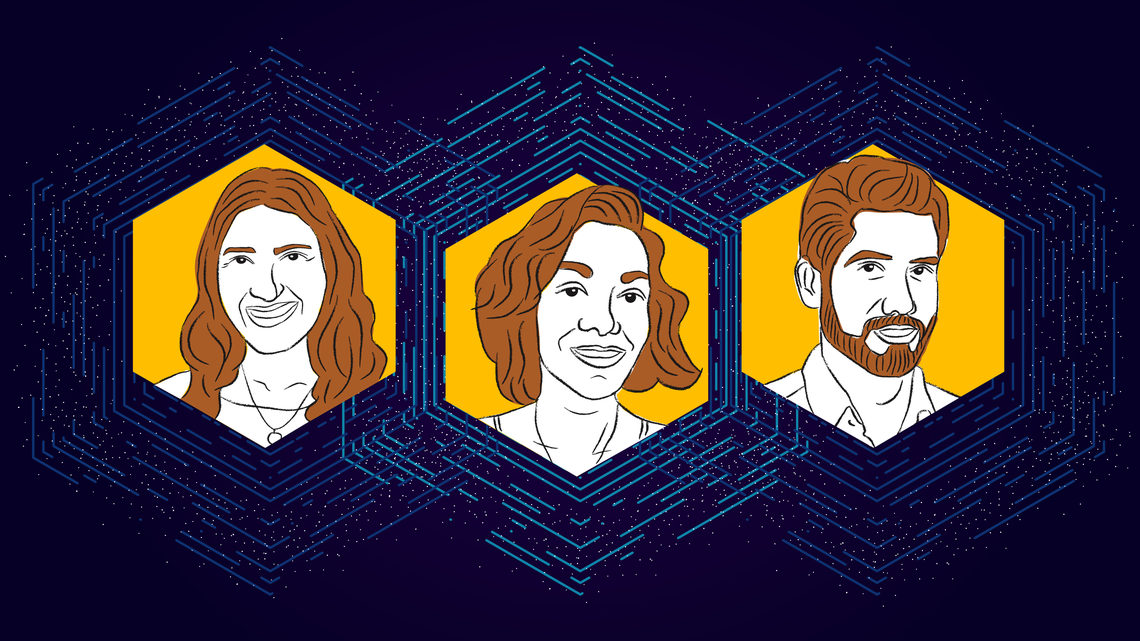
Continuing the trend
MINERvA hasn’t been the only force drawing Latin American researchers to Fermilab. Around the same time that Morfín began approaching Latin American institutions to collaborate on MINERvA, Fermilab theorist Marcela Carena, from Argentina, began a student program in the Fermilab Theory Department. Since the program’s inception, 15 students from Argentina, Brazil, Chile, Mexico and Peru have gotten involved in theoretical physics at Fermilab.
And even though the MINERvA experiment has finished collecting data, Latin American participation in neutrino research at Fermilab remains strong with the detectors that make up the lab’s Short Baseline Neutrino program (SBN) as well as the international Deep Underground Neutrino Experiment (DUNE), hosted by Fermilab.
Scientists on SBN will use three detectors, placed at locations within 600 meters from the source of Fermilab’s second neutrino beamline, to study how neutrinos oscillate. Data collected by SBN will help scientists determine whether there are actually more than three types of neutrino, as some previous experiments have hinted.
Mexico’s Center for Research and Advanced Studies of the National Polytechnic Institute has joined the SBN collaboration. And Betancourt says she is encouraging members of the MINERvA collaboration to join as well. “I find the start of an experiment to be the most exciting,” she says. “And SBN will begin within the next year.”
Building the detectors for SBN will also help scientists prepare for Fermilab’s upcoming flagship experiment, DUNE.
DUNE will study the properties of neutrinos using a new Fermilab neutrino beamline and detectors placed both at a short distance, similar to SBN, and at a much longer one: DUNE’s “far detectors” will be located 1300 kilometers (about 800 miles) away from the laboratory in a former mine turned high-tech underground laboratory called the Sanford Underground Research Facility in Lead, South Dakota. The four far detector modules, each 62 meters long and as high as a five-story building, will be the largest neutrino detectors ever built in the United States.
All of the Latin America-based institutions involved with MINERvA have already signed on to participate. “DUNE is now the fruit of all these efforts,” Morfín says. “There is now a concerted effort within Latin American countries to fully contribute to the success of DUNE.”
Perhaps among the young scientists who participate in SBN and DUNE will be the future advocates who will keep the relationships between Fermilab and Latin American institutions alive for generations to come.



